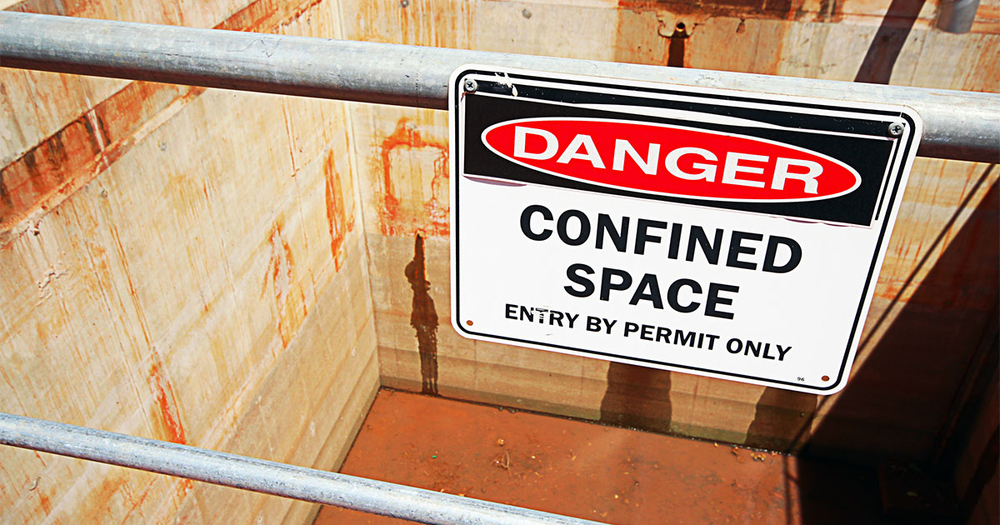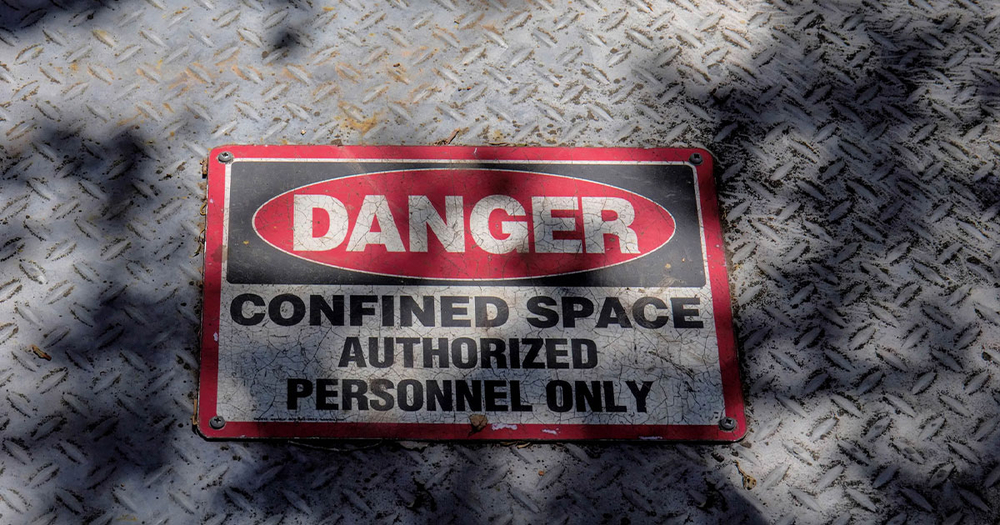
Confined spaces are narrow, cramped areas that are not designed for human occupancy. They are common in almost every industry, and many laborers will come into contact with at least one confined space during their work.
Confined space is a legitimate working hazard. According to Occupational Safety and Health Administration (OSHA), roughly 90 people die in confined spaces every year. And they are not just dangerous for the primary victim. Two-thirds of those fatalities are of people who were trying to rescue someone else from a confined space.
Without the proper confined space rescue equipment, workers are ill-equipped to stay safe in the event of a confined space emergency. Getting the proper equipment and understanding of confined space emergencies now can help workers make a successful rescue and stay safe on the job.
There are several ways that someone can get injured or die in confined spaces. Hazardous liquids and gases can be harmful if humans are exposed for too long. In enclosed spaces, a lack of oxygen could kill someone who is trapped in a confined space for only four minutes. A lack of light can lead to physical accidents and serious injuries.
Given these challenges, working in confined spaces is heavily regulated. Permit-required confined spaces include environments such as boilers, sewers, tunnels, or tanks. In these places, workers must wear specialized equipment and monitor the atmosphere. The employer needs to have a confined space rescue plan, rescue materials, and a rescue team in place.
There are three main types of rescue for confined space emergencies. Workers should receive rescue training that offers rescue drills and rescue services for all three.
In a self-rescue, the worker identifies a critical condition or new hazard and exits the confined space on their own. Alternatively, an entry monitor who is stationed outside the space may recognize danger, and order the workers to leave the confined space.
In a non-entry rescue, the rescuers assist the person inside the confined space to leave, without actually entering the space themselves.
An entry rescue occurs when the rescuers enter a confined space. This is the last resort option, due to the increased risk that comes with more people entering the space.
Acquiring the proper Confined Space Equipment makes for safer and easier rescues and greater protection against confined space hazards. It is necessary to be prepared, especially in permit-required confined spaces.

Mechanical winches and tripods are vital for non-entry rescues. The rescuer can extend a safety line to the person inside, and attach the other end of the rescue line to a tripod. The tripod can withstand large amounts of weight so that the rescuer does not end up dragged into the confined space. Furthermore, the tall legs of the tripod prevent it from blocking the entrance to the confined space.
There are several types of safety lines. The FCP Confined Space Tripod comes with either a 50’ Wire Rope, or a 50’ Stainless Steel Wire. Both can be purchased for $1,669. These tripods are strong, as they can withstand up to 5000 pounds of vertical load. They are both portable, and easy to set up and put away. The 7’ Tripod Carrying Bag makes for easy transportation of the equipment.
The same product can be purchased with a winch, which bumps the price to $2,028. The winch offers to raise and lowering capabilities. A friction brake prevents the unit from free-wheeling when under a load. If all you need is a winch, then FCP 50’ Galvanized Wire Rope Winch can be purchased on its own for $500.
In locations where it is impractical to use a Tripod, a Davit Arm is a good substitute. It is structured like a crane that reaches over the entry point to the confined space. The Permanent Davit Base can be installed in areas where Tripods can not be carried or do not fit the terrain. This Davit Base, which features an interchangeable arm that can rotate 360 degrees, can be purchased for $588. The FCP Riser Pole can be attached to several permanent bases at different locations. Each pole costs $559.50.
A full body harness is helpful for confined space entry and rescue operations. See the selection of Fall Protection Equipment for harnesses that are available. Generally, a fall protection harness is very similar to a body harness used for confined space rescues.
The harness is integral to rescue plans because it allows the rescue personnel to lift the victims out of the confined space in a timely manner. Typically, the employee is attached to the self-retractable lanyard through the dorsal D-Ring. This means that employees should have available Safety Harnesses, Safety Lanyards, and Self-Retracting Lifelines.
Continuous air monitoring is important for workers and emergency responders. In the event that dangerous gases are detected, it is best for everyone to evacuate the space immediately.
Gas clip technologies can detect dangerous gases and alert workers. That way, workers can evacuate before spending too much time breathing in the hazardous gases.
The Simple Gas Clip can detect oxygen (O2), Hydrogen Sulfide (H2S), and Carbon Monoxide (CO). This device is ready to withstand any working conditions and is highly reliable. Furthermore, it is inexpensive, at just $121.69 per unit. The Simple Gas Clip PLUS includes a Hibernate mode so that the device can be turned off when it is not in use. This feature makes the device, which tests for H2S and CO, perfect for seasonal contracts or rental fleets. It can be purchased for $145.78.
The Multi Gas Clip SIMPLE is an upgrade because it tests for four gases and does not need to be recharged. In addition to the gases tested on the Simple Gas Clip, the Multi Gas Clip tests for combustible gases (LEL). It lasts for two years without having to be recharged once. It can be purchased for $505.12. The Multi Gas Clip SIMPLE PLUS has the same capabilities but lasts for even longer. This clip, which lasts for three years, can be purchased for $745.
It is important that Gas Clips retain fresh and clean filters. Replacement Filters can be purchased in the event that fresh filters are needed for the Gas Clip. They can be purchased in packs of 10 ($20) or packs of 50 ($80). At $30, you can purchase an External Dust Filter Kit that helps to clean dust from Gas Clip filters.
You can purchase the Gas Clip Technologies IR Link. This connects the Gas Clip Technology to a computer. Using uploaded data, the technology can program special alarm set points, and user options, as well as, download event logs & data logs. For just $105, this is a great way to enhance data tracking of gases and communicate with workers using Gas Clip Technologies.
Finally, the Confined Space Test Kit holds two calibration hoses (one three feet, another ten feet), a hand aspirator pump, a foot-long sampling probe, an IR data link, and a regulator, all contained in a hard-sided carrying case. This can be purchased for $410. You can also add a 58L Quad Gas, which would bump the price to $577.71.
One strategy to stay safe in confined spaces is to ventilate the air. This helps circulate fresh air inside, and toxic gases out. ThePlastic Com-Pax-ial Blower is perfect for this purpose. The unit is designed with a quick-connect clipping system that allows workers to attach the canister, tools-free, to the input side for powerful extraction or the output side for ventilation. Buyers can choose between the 15’ foot option ($419) or the 25’ foot option ($457).
Confined space rescue training and equipment is the best way to prevent fatalities. Confined space hazards present real risks to workers in these environments, and can result in victims of preventable accidents. With the right planning, employers can preserve the safety and health of their employees.